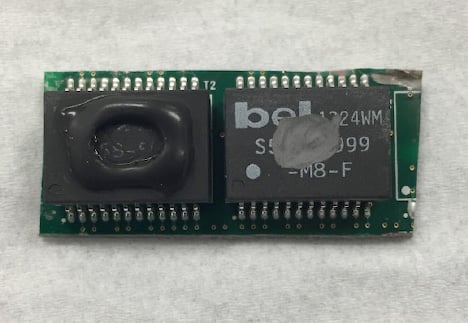ACI Technologies is tasked with decapsulation of electronics components for testing and investigative purposes. In the normal method of decapsulation, an analyst will drill a small indentation, with a rotary tool, in the hermetic sealant material and then apply Nitric acid to eat through the polymeric encapsulant.
ACI performs this decapsulation for a number of purposes, including wire bond inspection, operational testing, and counterfeit investigation. This testing method allows the operator to explore a silicon die while it’s still on a functioning board. Typical pieces being tested are 5x5mm in size.
In the traditional method of decapsulation, the operator makes a small well above the location of the die and places the component in a tin tray on top of a 140 deg. C hot plate. Nitric acid is then added in a dropwise fashion into the well for digestion of the packaging material. After 10-30 seconds, the acid is rinsed with acetone for neutralization. The process is repeated until the die and wire bonds of the package are exposed.
While the rotary-tool method is the standard practice, it does have some drawbacks. In particular:
Faced with these shortcomings of the current process, Scott Heston of ACI set out to find a better solution. He discovered that Texas Instruments had successfully used Pelseal 2078 Viton™ Caulk to assist with decapsulation. This caulk exhibits strong chemical properties and remains flexible in service. With those properties, Heston decided to adopt TI’s approach to build up a “well” using the caulk to contain the Nitric acid, rather than drill into the component.1
To form the well, Heston built up about 2-4 grams of Pelseal caulk above the die location (in place of carving out a small well) and placed the component on the hot plate. Once the component reached the correct temperature, he was able to drop nitric acid into the fabricated well and allow digestion of the packaging material. This was then rinsed with acetone and repeated until the die was exposed.
Here is what Heston found after utilizing the Pelseal®-constructed “well” method of decapsulation:
After determining the use of a Pelseal caulk “well” makes the decapsulation process easier and more effective, ACI will continue to utilize Pelseal caulk and plans to integrate it into their standard decapsulation procedures.

Two identical (side by side) components with Pelseal well on left and carved well on the right.
Photo courtesy of ACI
REFERENCES:
1 – “Safe Decapsulation Techniques Using Viton Caulk,” by Kristopher D. Staller, Texas Instruments, presented at ISTFA 2014: Conference Proceedings from the 40th International Symposium for Testing and Failure Analysis November 9–13, 2014, Houston, Texas, USA
Viton™ and any associated logo is a trademark or copyright of THE CHEMOURS COMPANY FC, LLC used under license by Pelseal® Technologies, LLC
Latest News
![]() Commercial Boiler Corrosion Solved with Pelseal Viton™ Caulk (read)
Commercial Boiler Corrosion Solved with Pelseal Viton™ Caulk (read)
Flanges leaking acid? You need FLANGE PELSEAL, our liquid Viton caulk. See the independent test results in our new photo brochure. (read)
Pelseal Technologies Featured In SULFURIC ACID TODAY Magazine (read)
Pelseal Technologies New PLV2020 Aerosol Coating Features the Properties of Viton™ Fluoroelastomer in a Convenient, 12 oz. Spray Can (read)
3161 State Road, Ste. G
Bensalem, PA 19020
Phone: 215-245-0581
Fax: 215-245-7606
sales@pelseal.com
Disclaimer: Information and suggestions supplied by Pelseal® Technologies, LLC ("Pelseal"), whether in published literature or otherwise, including samples, are based on technical data that Pelseal believes to be reliable. Such information and suggestions are supplied without charge and their use, and the use of Pelseal's products, are beyond Pelseal's control. Pelseal's products, information and suggestions are intended for use by persons having technical skill and know-how in the industry. Such persons are responsible, at their sole discretion and risk, to satisfy themselves regarding the suitability of Pelseal's products, information and suggestions for their particular use and circumstances. Any handling precaution information is given with the understanding that those using it will satisfy themselves that their particular use conditions present no health or safety hazards. NOT FOR RESIDENTIAL USE.